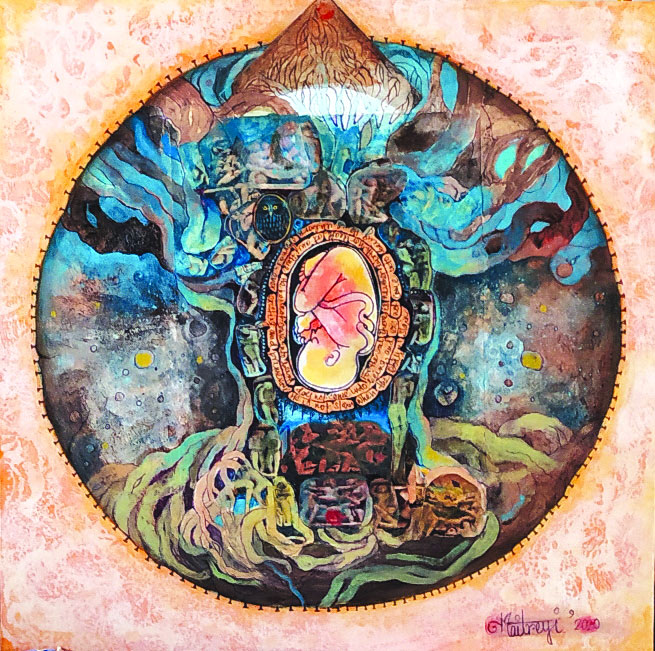Artist Maitreyi Nandi’s works depict the truth, which consists of herself, family and the experiences that designed her destiny, says Uma Nair
Artist Maitreyi Nandi put up collages/paintings on canvas that went beyond riveting. One look was enough to know her depth, density of thought and ability to weave metaphors and allegories that flit back and forth through time’s tapestry.
Her first painting — It Does not Die, depicts a foetus within a womb. The womb and the detailings are sensitively intricate and deeply inchoate in terms of resonance and reverie. Redefining the notion of hybridisation, Maitreyi conflates the symbols of Eastern and Western art historical traditions and political events to explore the intersection of individual experience and broader manifestations of culture. This collage is based on personal experience and the trauma and grief of losing her son.
Construction and composition
It is her construction and composition that endears, its almost as if we are looking at an image of the earth. She has constructed small and detailed replicas of historic architecture of nature’s intensities. Maitreyi emphasised the earth as a shelter and space as a vessel for life.
Its almost an exploration that unfolds like a series in which various creatures and characters emerge. She expands upon this theme with magical recreations. When we look closely at her little vines and creepers and forms that surround the little baby, its almost as if we are looking at fertile basins from which culture springs. In her second image, Fleeting Feet again, we see an iconic structure of two feet with bangled thorns.
Fleeting Feet
This one is fascinating. She quotes Frida Kahlo: “Feet what do I need you for when I have wings to fly?” Maitreyi is a voracious reader. You can’t create such works of deep thought and substance without literary associations. She places her feet on lush aqua flora: planting them with a variety of foliage, as well as a foreground of scaly biological exotica; it’s almost as if she reimagines these seedbeds for a more peaceful life, but in effect renders them inert. The branches that ensue on top of the feet are more about the earth’s soil and what lies above the horizon. But she draws our attention to the anklets of thorns. Tied down by despair and sorrow such a Frida Kahlo moment.
Maitreyi is like a mute planter, her symbols of sorrow and deep grief grow into ruined relics, as creeping vines cover the façades of her canvas. Her works continue to subvert traditional modes of thinking and cultural stereotypes. She extols the virtues of experience which teaches that even if there are scars, they give us sombre reveries drowned in melancholia.
Sadness gives us time to think; Maitreyi has an uncanny ability to dissect cultural and aesthetic creations on canvas and create seemingly distinct juxtapositions which unfold into nuanced takes on history, natural identity, and artistic practice.
She tells us, “My earlier works were soft, soothing and happy, but things changed after a life-altering event. At some point we have all faced it. Whether it be the death of a loved one, a serious illness or some experience that reminds us of what really matters in life. In the blink of an eye, everything can change. Often, these life experiences can teach us valuable lessons, help us discover inner strength, and help us realise what is truly important in our life...I lost my son in 2014. He was only 22 years old.
Being a single mother, life has taught me a lot! I’ve learnt that the only real thing in this world is our consciousness. Physical matter is all a holographic illusion... Life has changed me this way and these concepts reflects on my paintings too…”
And once again Maitreyi brings back the unforgettable words of Frida Kahlo. “I never painted dreams. I painted my own reality.” For this, Maitreyi from Gurugram is a rare artist who transcends her real world to enter into the meandering islands of surrealism, conjoined to Mother Earth. Her reality consists of herself, her family and those experiences that designed her destiny, to influence her surrealism — agonised poetry on canvas.


























